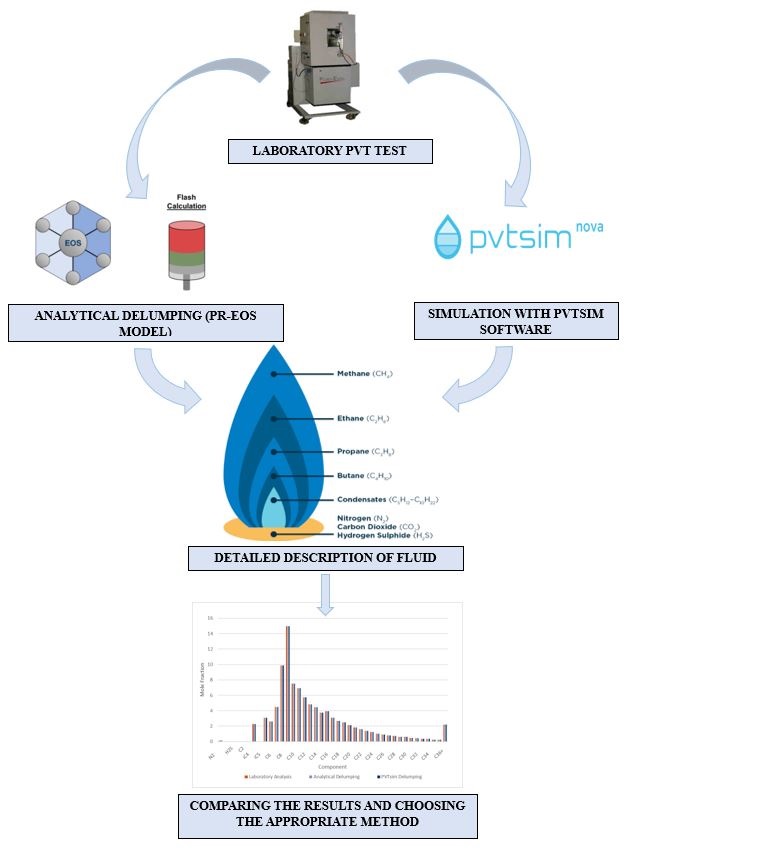Pressure-volume-temperature analysis of Caspian oil to improve the analytical delumping procedure
DOI:
https://doi.org/10.15587/1729-4061.2024.297769Keywords:
delumping, pseudo-component, plus fraction, BIP, EoS, PVT, K-value, Caspian oilAbstract
Compositional modeling of the reservoir isn’t complete without calculations of phase equilibrium and is a complex process involving many calculations. In nature, hydrocarbons don’t occur as separate components, they’re mainly mixtures. When modeling the reservoir composition for phase equilibrium calculations, in order to reduce computational costs, in practice, hydrocarbon mixtures are grouped into pseudo-components. The number of grouped pseudo-components varies from 4 to 10. This grouping process is called lumping. However, when crude oil comes to the surface, it’s important to know its detailed composition, since mixtures grouped into pseudo-components don’t allow you to know this. In this regard, modeling of the detailed composition of hydrocarbons is the main tool for understanding the detailed phase separation and design of surface facilities. In practice, this process is called delumping. In the case of this process, the detailed composition of the fluid is presented and the amount reaches up to 36 components, sometimes more. The delumping process, due to the precise separation of heavy plus fractions into carbons with single ordinal numbers (C7, C8, etc.), makes it possible to clearly recognize non-zero BIP’s in the equation of state.
The new analytical approach has not previously been applied to the oils of the Caspian region, so this approach has an important role for the oil industry in the Caspian region. Analytical delumping in this paper was done to improve the PVT modeling. This paper presents the results of PVT research of Caspian oil and presents a comparison of analytical and numerical methods of delumping. As a result of the study, it was found that the analytical approach is in excellent agreement with experimental data and data from software such as PVTsim
References
- Leibovici, C. F., Barker, J. W., Waché, D. (2000). Method for Delumping the Results of Compositional Reservoir Simulation. SPE Journal, 5 (02), 227–235. https://doi.org/10.2118/64001-pa
- Kuntadi, A., Whitson, C. H., Hoda, M. F. (2012). Dynamic Delumping of Reservoir Simulation. All Days. https://doi.org/10.2118/159400-ms
- Ismailova, J. A., Khussainova, A. R., Zerpa, L. E., Delikesheva, D. N., Ismailov, A. A. (2023). A new predictive thermodynamic model of paraffin formation with the calculation of the mathematical origin of the poynting correction factor. Series of Geology and Technical Sciences, 3 (459), 96–107. https://doi.org/10.32014/2023.2518-170x.302
- Ismailova, J., Abdukarimov, A., Kabdushev, A., Taubayev, B. (2023). The implementation of fusion properties calculation to predict wax deposition. Eastern-European Journal of Enterprise Technologies, 4 (6 (124)), 18–27. https://doi.org/10.15587/1729-4061.2023.281657
- Leibovici, C., Stenby, E. H., Knudsen, K. (1996). A consistent procedure for pseudo-component delumping. Fluid Phase Equilibria, 117 (1-2), 225–232. https://doi.org/10.1016/0378-3812(95)02957-5
- Nichita, D. V., Broseta, D., Leibovici, C. F. (2007). Reservoir fluid applications of a pseudo-component delumping new analytical procedure. Journal of Petroleum Science and Engineering, 59 (1-2), 59–72. https://doi.org/10.1016/j.petrol.2007.03.003
- De Castro, D. T., Nichita, D. V., Broseta, D., Herriou, M., Barker, J. W. (2011). Improved Delumping of Compositional Simulation Results. Petroleum Science and Technology, 29 (1), 1–12. https://doi.org/10.1080/10916460903330098
- Chen, C., Su, W., Xing, L., Lin, X., Ji, D., Zhou, N. (2023). A prediction model for the binary interaction parameter of PR-VDW to predict thermo-physical properties of CO2 mixtures. Fluid Phase Equilibria, 565, 113634. https://doi.org/10.1016/j.fluid.2022.113634
- Al-Marhoun, M. (2023). Estimation of Missing Molecular Weight and Specific Gravity of Heptane Plus Fraction in PVT Laboratory Report. Middle East Oil, Gas and Geosciences Show. https://doi.org/10.2118/213430-ms
- Góes, M. R. R. T., Guedes, T. A. L., d’Avila, T., Ribeiro, L. D., de Campos, M. C. M. M., Secchi, A. R., Tavares, F. W. (2022). Improvement of black oil delumping method applied to an offshore oil field. Journal of Petroleum Science and Engineering, 214, 110514. https://doi.org/10.1016/j.petrol.2022.110514

Downloads
Published
How to Cite
Issue
Section
License
Copyright (c) 2024 Jamilyam Ismailova, Ayaulym Baibekova, Dinara Delikesheva, Aibek Abdukarimov, Alfiya Khussainova

This work is licensed under a Creative Commons Attribution 4.0 International License.
The consolidation and conditions for the transfer of copyright (identification of authorship) is carried out in the License Agreement. In particular, the authors reserve the right to the authorship of their manuscript and transfer the first publication of this work to the journal under the terms of the Creative Commons CC BY license. At the same time, they have the right to conclude on their own additional agreements concerning the non-exclusive distribution of the work in the form in which it was published by this journal, but provided that the link to the first publication of the article in this journal is preserved.
A license agreement is a document in which the author warrants that he/she owns all copyright for the work (manuscript, article, etc.).
The authors, signing the License Agreement with TECHNOLOGY CENTER PC, have all rights to the further use of their work, provided that they link to our edition in which the work was published.
According to the terms of the License Agreement, the Publisher TECHNOLOGY CENTER PC does not take away your copyrights and receives permission from the authors to use and dissemination of the publication through the world's scientific resources (own electronic resources, scientometric databases, repositories, libraries, etc.).
In the absence of a signed License Agreement or in the absence of this agreement of identifiers allowing to identify the identity of the author, the editors have no right to work with the manuscript.
It is important to remember that there is another type of agreement between authors and publishers – when copyright is transferred from the authors to the publisher. In this case, the authors lose ownership of their work and may not use it in any way.









